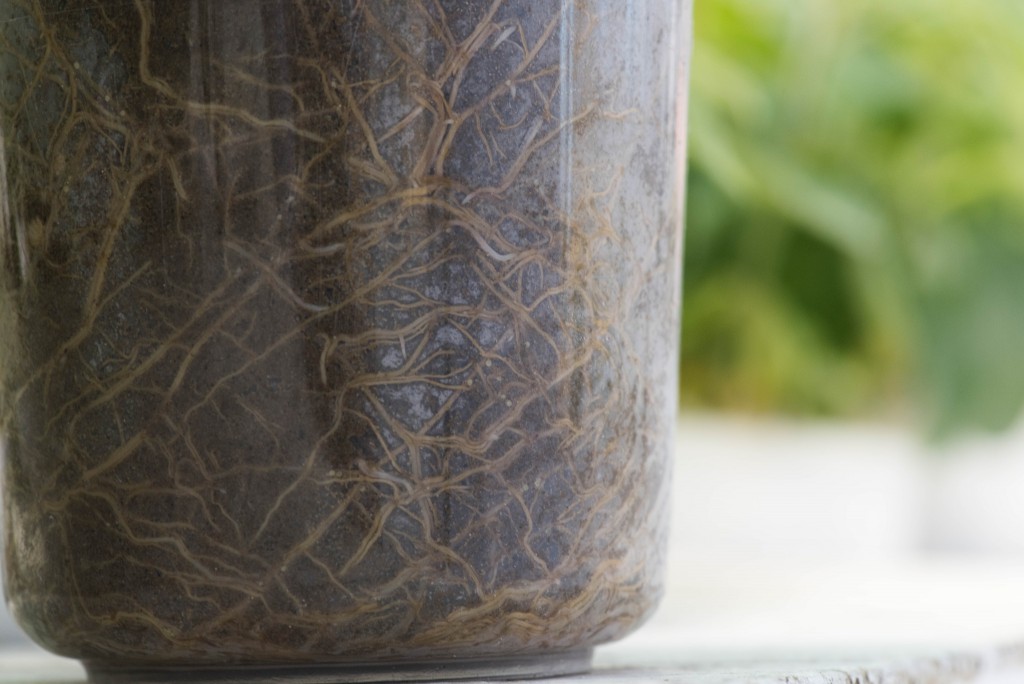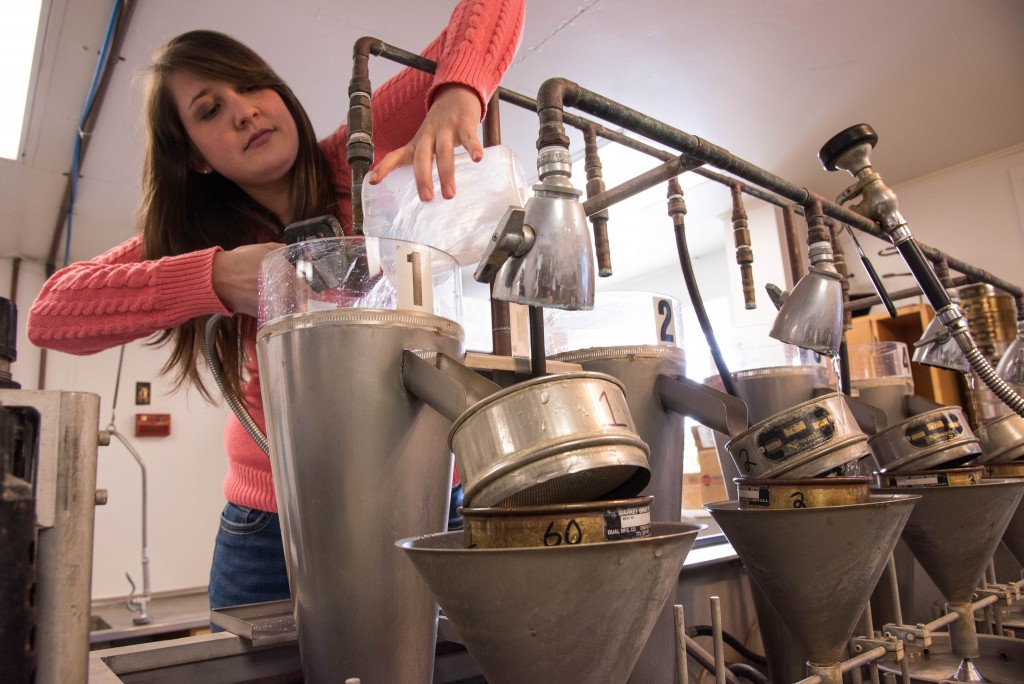
Beneath a North Carolina field in 1954, a tiny worm inched its way through the soil and butted against a soybean root. The worm pierced the plant, slipped inside and inserted a needle-like appendage into a cell. It pumped a mixture of proteins into the root cell and waited for the potent blend to take effect on the unsuspecting soybean.
Since the first detection of soybean cyst nematode (SCN) in the US, the worm Heterodera glycines has spread to about 80 percent of American soybean fields. In Missouri, SCN attacks soybeans in almost every county and causes decreased yields even in robust, healthy-looking fields. Nationwide, SCN wreaks havoc to the tune of $1.2 billion per year, making it by far the most costly soybean pest.
Despite the hefty toll, farmers still depend on the same small handful of resistant soybean varieties to combat SCN that they have used for years. But those natural defenses are becoming less effective as nematodes evolve.
“More than 90 percent of the soybean cultivars that farmers plant derive their resistance from a single source,” said Melissa Mitchum, a plant nematologist at the University of Missouri Bond Life Sciences Center and Division of Plant Sciences faculty member in the College of Agriculture, Food and Natural Resources. “Consequently, this has led to widespread virulence in the pathogen population, thereby reducing the effectiveness of those resistant cultivars.”
But in the past 10 years, researchers studying SCN have made numerous breakthroughs, unlocking the secrets of the nematode and exploring how the worm interacts with host plants. Now, scientists are poised to bring that knowledge from the laboratory to the field.
Found in translation
Relatively little was known about SCN a decade ago.
Scientists could determine the type of nematode in a soil sample and had just figured out the cocktail of proteins a nematode pumps into the soy root cell that transform it into a syncytium, or feeding cell.
Working in part with funding from commodity boards and farmer checkoff dollars, researchers around the country made breakthrough after breakthrough, deepening our understanding of SCN and equipping scientists with new tools to fight the pest.
That money helped scientists sequence the soybean genome, draft a SCN genome and pinpoint important soy and SCN genes.
Checkoff investments continued to pay dividends in 2012 when Mitchum and colleagues cloned the first gene linked to natural soybean cyst nematode resistance. This breakthrough is one key step in moving science from the laboratory into the field. With a SCN resistance gene in hand, new avenues for creating soybean varieties that fight off the nematode are opening up.
But other areas of research also hold promise in the struggle against soybean cyst nematode’s parasitic ways.
Mitchum’s group also identified the plant receptors that recognize and respond to the blend of proteins an attacking nematode inserts into a plant. In a recent project published in Plant Biotechnology Journal, Xiaoli Guo, a postdoctoral fellow in Mitchum’s lab demonstrated that silencing those receptors in soybean roots helped the plant resist SCN.
This work has implications for more crops than just soybeans: Working with collaborator Xiaohong Wang at Cornell, Mitchum’s group used their understanding of plant receptors to develop a potato resistant to potato cyst nematode.
A roadmap for discovery
To build on the momentum of recent research, experts drafted a roadmap for the next decade of nematode research. Their goal, Mitchum said, is to address the challenge of translating these research breakthroughs into something tangible for the farmer.
With support from state farmer run organizations such as the Missouri Soybean Merchandising Council, the North Central Soybean Research Program and the United Soybean Board, researchers are formulating teams that “bring together commodity, industry and university funding to develop collaborative, interdisciplinary, multistate projects,” said Mitchum.
And there’s plenty of scientific firepower to advance research: MU’s College of Agriculture, Food and Natural Resources alone has more than 90 faculty studying plant science, plant genetics and other areas of agriculture-related science.
The scientists’ plan for the next 10 years involves a blend of molecular research, plant breeding, population biology and outreach. Researchers will focus on refining the existing draft SCN genome, which will help to develop a quick, inexpensive test for HG type and eventually contribute to understanding of how SCN overcomes a plant’s resistance. They’ll create an “atlas” of SCN genes researchers can use to block the pest. Updating yield loss estimates and mapping SCN distribution will also give scientists a better idea of the nematode’s national impact. Other efforts will allow breeders to incorporate new sources of resistance into commercially-available varieties, refine the use of non-host species to control SCN and develop a pipeline for creating and testing transgenic SCN-resistant soybeans. Finally, videos, webinars and training modules will help scientists, students and producers take advantage of new discoveries and techniques.

Onward with research
A thorough understanding of SCN resistance and virulence starts with basic research and then moves into the field. “We all need to come together to transfer this knowledge to the breeder,” Mitchum said, “and from there it gets out to the farmer.”
Her lab recently received a National Science Foundation grant to continue their work on soybean protein receptors. Specific targeting of the receptors is just one potential strategy for producing new kinds of SCN-resistant plants. A second grant, from the National Institute of Food and Agriculture, will allow the lab to continue refining their understanding of how SCN proteins overcome a host plant’s defenses. To that end, Mitchum’s graduate student Michael Gardner is identifying the genetic blueprint of the different SCN types present in Missouri fields.
“If we better understand nematode populations and what makes those populations distinct, we can better advise farmers confronted with virulent nematodes,” Gardner said. “We’ll be able to go one step beyond the HG type test and understand how nematodes are able to adapt in the long term, not just the next growing season.”
But these breakthroughs do little good unless they then become useful tools for breeders and ultimately farmers. To that end, Mitchum and other researchers will help breeders use research results to produce soybeans with durable resistance. They‘ll also develop guides so farmers can easily incorporate new technologies and management strategies into their farms.
It’s important for farmers, breeders and researchers to take a unified approach to fighting SCN, Mitchum said, because a tactic that seems successful at first could backfire.
For instance, combining resistance genes in a single soybean variety could actually be harmful. “When we deploy it in the field, we select for nematodes that can overcome multiple types of resistance,” Mitchum said.
A better approach might be to perfect varieties with distinctive resistance mechanisms and insure durable resistance by rotating among the resistant varieties and non-host crops.
“It’s similar to taking antibiotics,” Mitchum said. “Improper use and overuse selects for resistance.” The strategic planning document should help everyone working with soybeans and SCN leverage and build upon new knowledge.
Despite all the research and recent breakthroughs, there remains only one certainty in the ongoing arms race between soybeans and SCN: “It is highly unlikely that we will eradicate it.” Mitchum said, “We’re going to have to find new strategies to protect and bolster soybean yields.”
Thanks to the efforts of researchers such as Mitchum, in the future SCN might be a little easier to get along with.

University of Missouri Plant Nematology Laboratory: An extensive legacy
Bob Heinz spent his last day at work in December surrounded by nematodes. Heinz served as Mitchum’s research specialist and coordinator of the Plant Nematology Laboratory, where he processed soil samples, responded to growers and assisted researchers. After 35 years on the job, he’s retired, and Amanda Howland is now filling his shoes. The scientists and farmers who’ve worked with Bob over the decades thank him for his dedication and wish him luck in his retirement. And Amanda: Welcome aboard.
The Plant Nematology Lab, housed within Mitchum’s lab at MU, represents a successful model for how research, teaching and extension program integration can promote interdisciplinary collaboration. Such an approach helps maintain an effective pipeline that brings research-based information and resources from MU to Missourians. The lab offers an array of tests that help farmers understand and manage nematode populations. The available tests include:
–Vermiform Nematode Identification: Soybean Cyst? Root Knot? Lesion? Find out what kinds of nematodes are in your fields with this test.
–Soybean Cyst Nematode Egg Count: This procedure provides an estimate of the number of SCN eggs in your field.
–Soybean Cyst Nematode HG Type Test: Different types of SCN have overcome various sources of soybean resistance. A HG type test will help you determine the best source of resistance for the particular type of SCN in your field.
For more information, go to http://soilplantlab.missouri.edu/nematode/ or contact the Lab.
Phone: 573-884-9118
Email: nematodelab@missouri.edu

